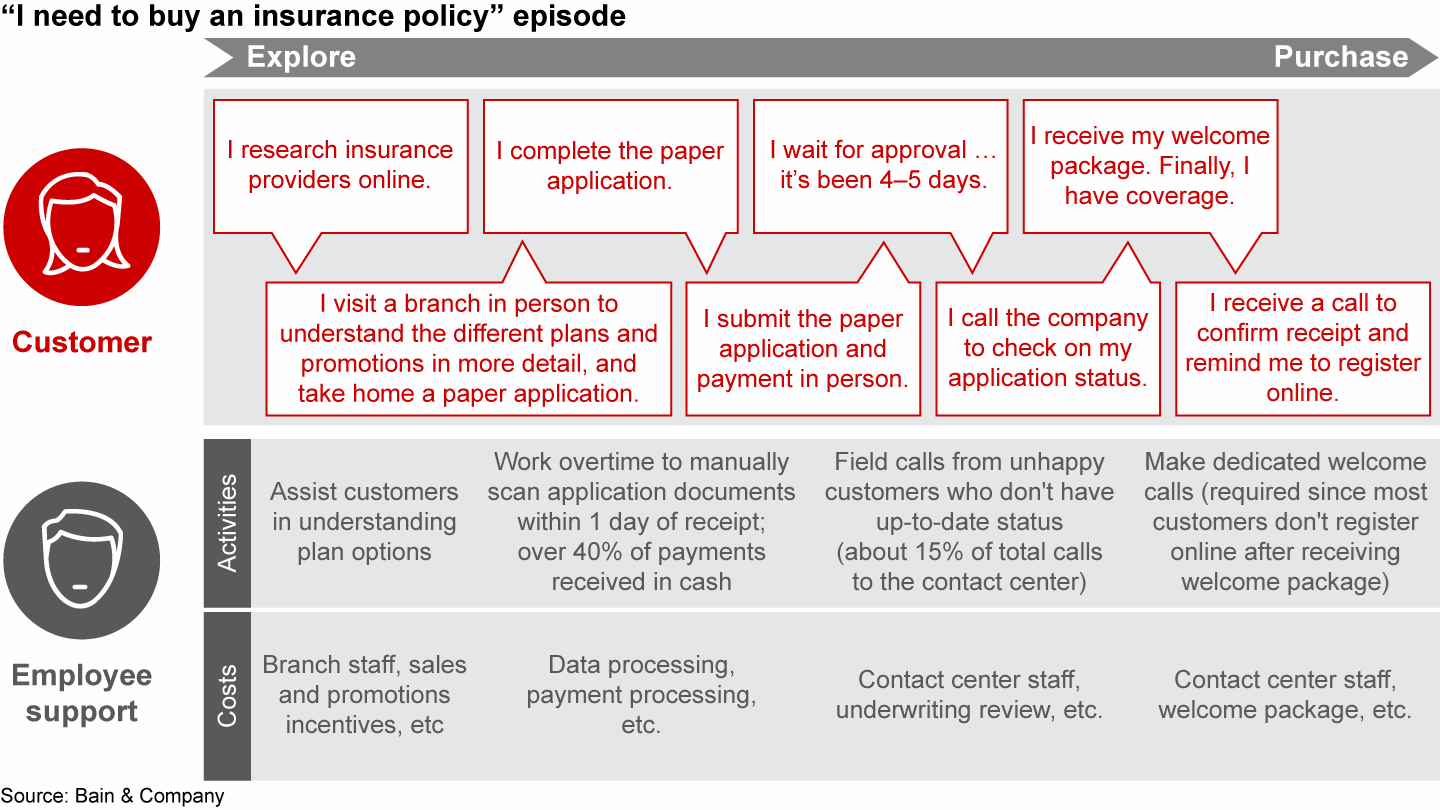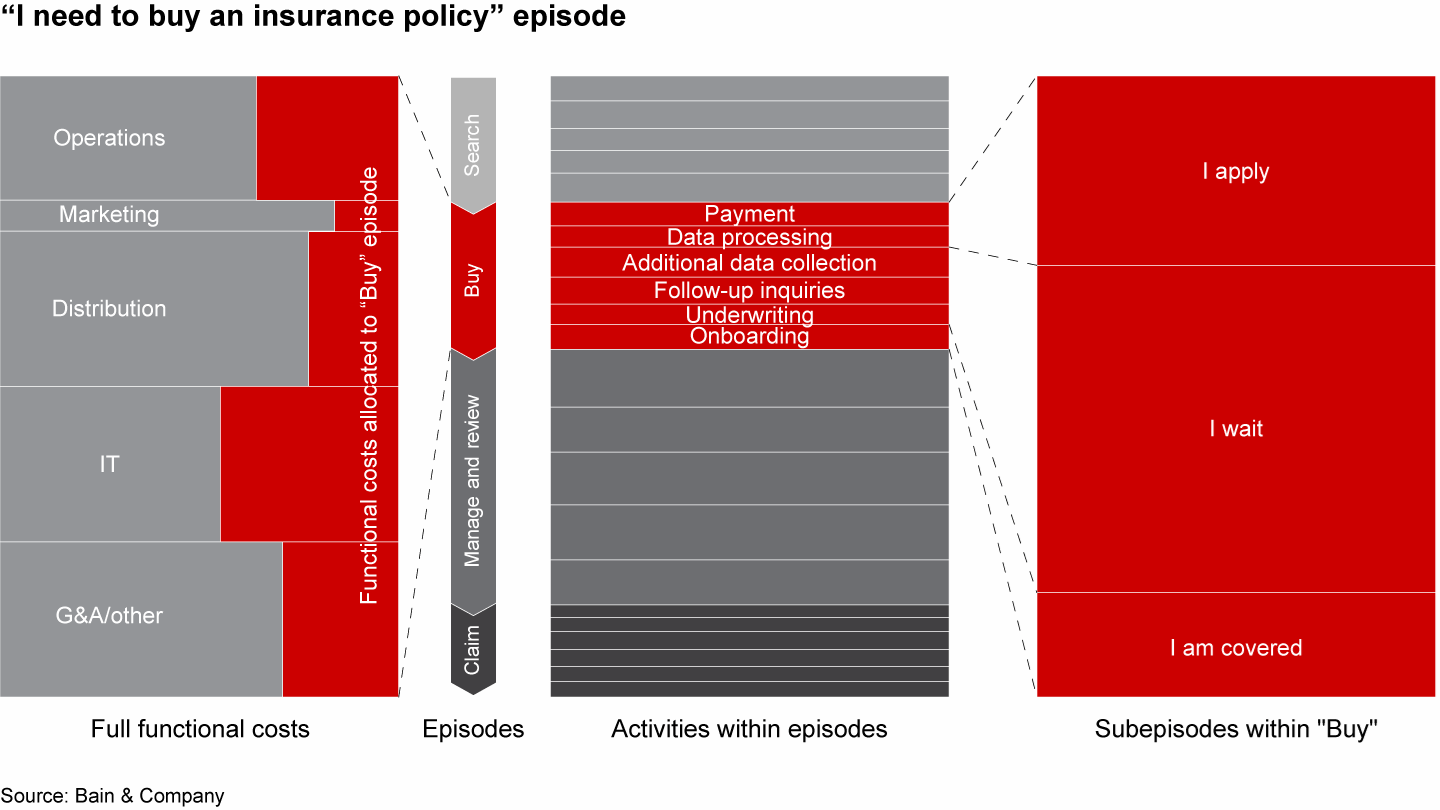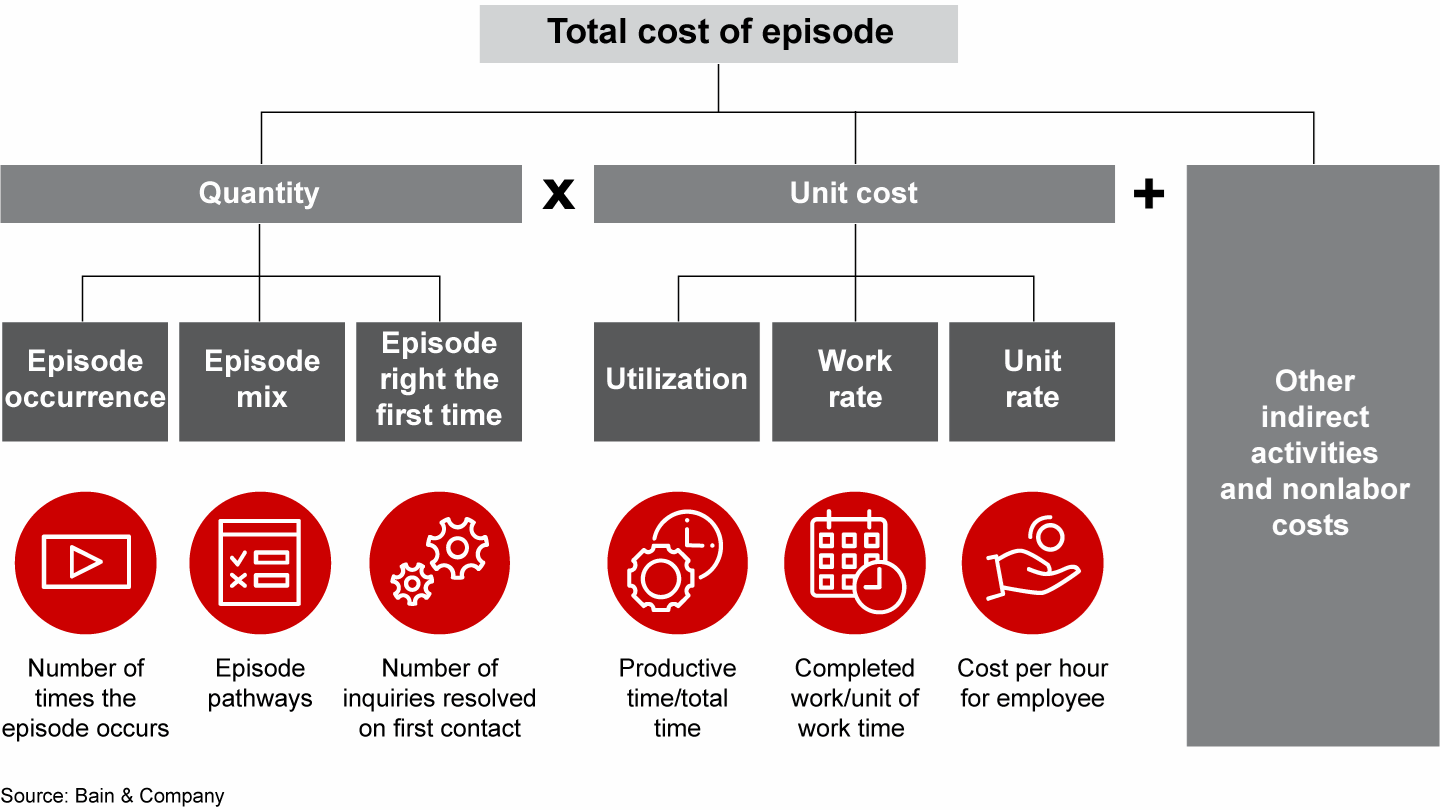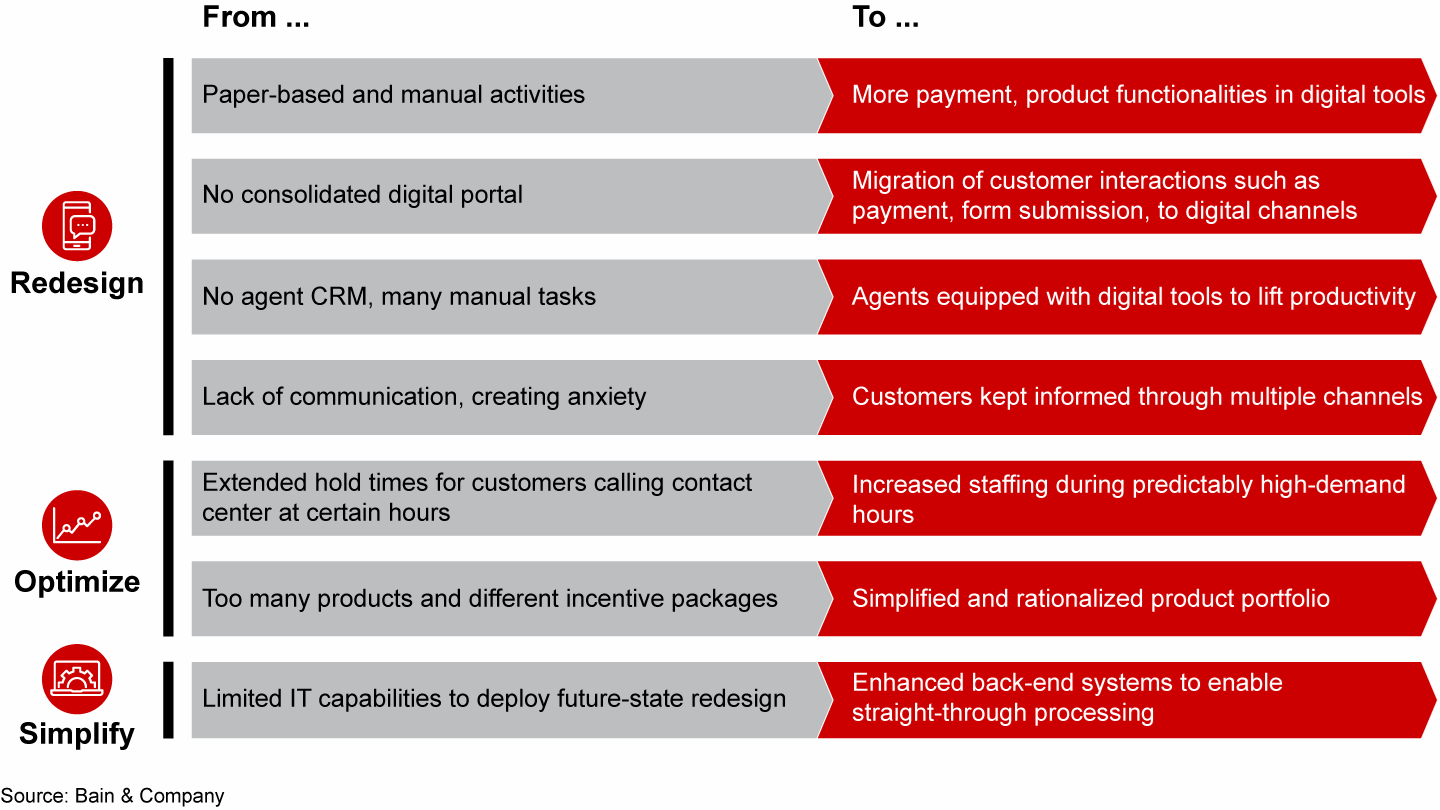Brief

In evidenza
- Improving the customer’s experience with an insurance company or bank does not automatically conflict with cost-containment goals.
- Reducing bad volume, offering more self-service options for basic transactions and rationalizing the product mix can deliver a better experience at lower cost.
- To make headway on both goals, companies should focus on discrete customer episodes—such as “I want to purchase a life insurance policy to protect my family”—identify the episodes that matter most to customers and target the unit cost of each episode.
- The key characteristics of more effective and efficient episodes are simple, digital, fast and right the first time.
Senior executives at insurers, banks and other financial services companies often believe they must make trade-offs between two opposing forces: improving the customer experience and managing costs. “Good service is expensive,” goes the thinking, “so managing costs will be difficult if we try to provide better service.”
That belief might contain a grain of truth with traditional customer experience programs run through organizational silos, or cost-cutting programs focused narrowly on reducing headcount. In some cases, initiatives to create a well-designed experience lead to beautiful visions, but operations and IT teams cannot deliver the experience because they haven’t figured out the path through complex legacy processes, policies and systems. In other cases, dozens of IT initiatives take the upper hand, but it’s not clear how they will improve the customer experience. These initiatives do not reduce underlying complexity and may even degrade the experience.
Consider the claims process in home or auto insurance. Customers often complain about being in the dark for days or weeks after they’ve submitted a claim. Anxious customers call the contact center, creating bad volume. Or consider the policy application process, with its copious paper forms that customers must fill out and insurers have to scan, index, augment through data entry and check for accuracy. Even when digital tools exist, such as sales apps for agents or digital claims submission for customers, entrenched behaviors often deter widespread adoption.
There’s a better way to deal with this dilemma. Companies can more efficiently deliver higher product or service volumes, freeing up funds to reinvest in growth areas. Taking out operational costs and improving the customer experience become two sides of the same coin. Companies can attain both goals by reducing bad or avoidable volume, such as unnecessary calls to the contact center; offering more self-service options for basic transactions, which customers actually want; and rationalizing the product architecture and mix. These steps lead to a better experience, which accelerates revenues through greater customer loyalty and a larger share of wallet.
The customer episode as a unit of change
Virtually all banks and insurance companies have been migrating many transactions to digital channels. Yet there is substantial variation in the pace of change and the return on investment. How can they make substantial progress?
We have found that the most effective unit of transformation is the customer episode, which provides a powerful lens to reduce companies’ cost position without degrading the experience. When customers have a task to complete or a need to fulfill through the company, that’s an episode. It has a clear start and end, marked by the customer completing what he or she set out to do. Episodes encompass a variety of purchase, usage or service activities; they range from a single interaction (such as paying a bill online) to an intricate series of interactions spanning weeks (financing a new home). The sum of episodes over time constitutes the entire experience of dealing with the company. Focusing on episode costs allows the company to determine how efficiently it is serving the customer’s needs (see Figure 1).
Many episodes cause customers pain and incur unnecessary costs for the company along the way


For many episodes, the critical characteristics are simple, digital, right the first time, fast and personalized. From the customer’s standpoint, a highly manual episode usually takes longer, invites mistakes and makes it difficult to stay informed. Manual, complex processes and systems also add costs in employee time and in lost business, when customers defect to competitors. The “simple and digital” alternative partly explains why direct banks tend to outperform traditional banks on customer loyalty metrics, and explains the rise of fintechs such as Quicken Loans, whose Rocket Mortgage offering has made it the leading direct-to-consumer mortgage lender in the US.
For the cost side of the equation, leading companies find it useful to take an activity-based approach to understand the unit cost of each customer episode. First, you map the full spectrum of activities in an episode. Buying an insurance policy, for example, would include data entry and processing, underwriting and fielding customers’ calls about their application status. Then you take the functional costs from the general ledger (operations, distribution, IT and so on) and assign them to each activity, such as how many contact-center calls pertain to buying a policy (see Figure 2). This analysis allows you to identify hot spots—the activities that cause customers pain and have high costs—that should be prioritized for resolution.
Functional costs from the general ledger are allocated to each episode according to the activities involved


Using the episode lens helps you pinpoint issues that might otherwise slip through the cracks, such as why customers are calling the contact center. An episode lens also holds executives accountable for episode performance, by measuring both the cost and the quality of the experience.
To reduce drivers of cost (see Figure 3), and improve the episode in the bargain, companies use levers ranging from digital submission of forms, to automatic status updates, to optimized workforce scheduling of contact-center agents. These levers also enhance the quality of the episode. For instance, switching from paper to digital applications eliminates data entry, and an auto-underwriting engine can automatically assess the vast majority of cases, which translates to faster processing times and happier customers.
For each customer episode, various levers can reduce costs


Similarly, for the “open an account” episode in banking, simplifying the process through digital channels can reduce the share of incomplete applications requiring a follow-up call. At one Australian bank, about half of customers started the account-opening process online, but only 24% of those people completed the application digitally while more than 40% simply dropped out. The bank is redesigning the end-to-end account-opening episode, addressing the issues that cause customers to quit along the way.
Automation can support a simple and digital shift by minimizing human intervention and creating a true end-to-end process. Episodes also tend to improve through simplified product lines and processes, which make for greater reliability and speed. In addition, you can reconfigure where and by whom the work gets done. Each of these levers involves behavioral change, especially overcoming barriers to both employee and customer adoption of digital tools—whether those barriers consist of lack of confidence, lack of understanding the benefits or simply inertia.
Simplification appeals to customers in the form of faster and more intuitive transactions. It also unlocks benefits for employees and the broader organization, in the form of reduced training needs, employee attrition and testing costs for future IT changes.
A multinational insurer based in Asia launched a cost-led simple and digital initiative focused first on a couple of episodes, including researching and applying for a life insurance policy. The company identified pain points for customers and employees, including long service times, paper-intensive processes and redundant activities. Cross-functional Agile teams with dedicated funding were charged with improving individual episodes while also reducing costs (see Figure 4). The episode owners were accountable for both unit cost and customer ratings of the episode.
How an insurer improved episodes and took out costs


Across the full program, the insurer is on track to realize dramatic benefits, including a 30-point increase in episode-level Net Promoter Score® (a key metric of customer loyalty), a 19-point rise in employee engagement and a 30%–50% reduction in unit costs for various episodes.
Key questions to get started
Applying an episode lens serves financial services companies well in several situations. Some are trying to deliver a better experience and scale up growth efficiently. Others aim to accelerate the use of digital tools but want to realize a higher return on that investment. And still others have the foremost goal of a broad cost-reduction program, without letting the experience suffer. The latter goal is timely, as the economic expansion grows long by historical standards and a recession appears more likely in the near future.
For executives looking for a better way to contain costs while improving the customer experience, it’s useful to frame the effort by answering a set of key questions:
- Do we have a clear sense of our competitive position in terms of the customer experience and unit cost per episode? What position do we aspire to?
- Where are the biggest drivers of the experience and cost—which episodes, products, services and channels?
- What levers for improvement, such as digitization and process redesign, will yield the most progress toward both objectives?
- How will we need to adjust our operating model and technology stack to reach our goals?
- Are we investing in the right capabilities, such as Agile methods, to unlock the full-potential cost benefits?
Leading financial institutions have discovered that a better experience can be consistent with lower costs. Reducing IT and process complexity, and automating manual steps where possible, will make both customers and employees happier—leading to economic improvements that benefit shareholders as well.
Richard Hatherall and Priscilla Dell’Orto are partners with Bain & Company’s Financial Services practice. Karsten Fruechtl is a partner with Bain’s Customer Strategy & Marketing practice. They are based, respectively, in Sydney, Hong Kong and Melbourne.
Net Promoter Score® is a registered trademark of Bain & Company, Inc., Fred Reichheld and Satmetrix Systems, Inc.